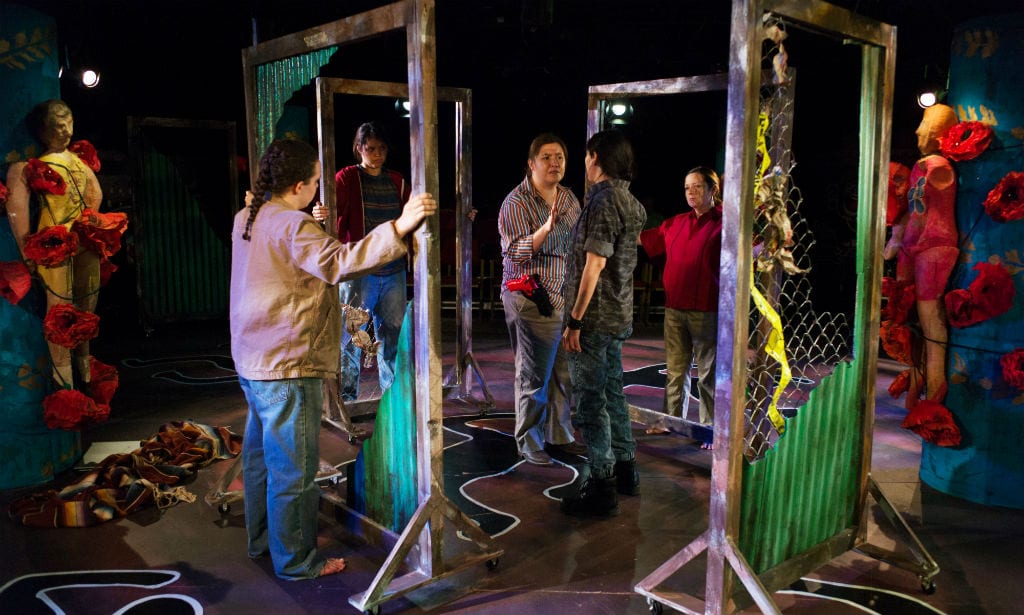This play is a tapestry of culture and menace that refuses to release you from its grip. Crime scene dead body outlines on the floor are integrated into a vibrant folkloric design, with oversized gory red poppies and puta dolls strung on the massive columns in the underground theater space. There are wonderfully horrible assemblages in each corner of the room, like Mexican Day of the Dead decorations on an unnerving scale, always just outside your peripheral vision.
This is “part two”. (Part One was reviewed here.) But these aren’t in any important way (so far) parts of a single story, rather plays in a common lyrical style about the incredibly dark, inhuman world of narco-dominated Mexico. Murder on the slightest pretext is so common in this world that Olmos uses the device of characters becoming ghosts upon death and continuing to comment on the drama. After death they speak anguished truths in shimmery voices (thanks to excellent sound design by Bruce Dubose). Here in Part Two, they often remind us of the staggering, ungodly toll of narco-terrorism on children, who never actually appear on stage. Childhood, along with normal life in general, seems to have been abolished and obliterated long ago.
It’s a world driven, we are also reminded, by the ceaseless appetites of “the America”. Spanish language, mexicanisms, and Mexican cadences are used liberally so we always feel it when we’re not on our comfortable side of the border.
All the characters are male, macho in the extreme, crazily dominant, violent. The decision to cast them all with female actors was the playwright’s, I’m told, to make some of the most brutal anti-woman language more palatable. I don’t know if it had that effect. Frankly, the characters read to me as strong females, not socially as males. I think there’s a difference, but maybe generating the distance to make us wonder about that is part of the point.
The action revolves around the rivalry between two gangs. There are violent orders, cold threats, pitiless acts of monstrous retribution. Olmos uses dance, ballads, and compressed rap rhythms to carry us through the shifting allegiances and horrors as the crime organizations constantly innovate to push the product through. Mules, planes, and tunnels all figure. Rolling sections of border fence are configured and reconfigured through the play in somewhat unspecific ways.
Stephanie Cleghorn Jasso is the only holdover from Part One, here playing El Azul, an ambitious narco maybe a bIt too reminiscent of Tony Montana in Scarface. Jasso has the lyrical intensity and groundedness to fulfill Olmos’ style. Also noteworthy is Gloria Vivica Benavides as El Jefe, the once powerful boss aging out of the action amidst El Azul’s rise. Mindamora Rocha has the toughest job, a droopy tool who transforms the most under the sick, murderous pressure of El Azul.
Part one centered on the true story of a young woman willing to challenge the narcos as chief of police. There isn’t anybody to root for in Part Two, no federales bringing the evil ones to a grisly final justice. We are left at a loss, unable to think of these faraway problems as so very far away after all.
Part Three is in the works. We’ll be back.


